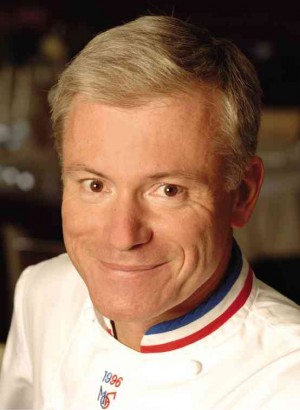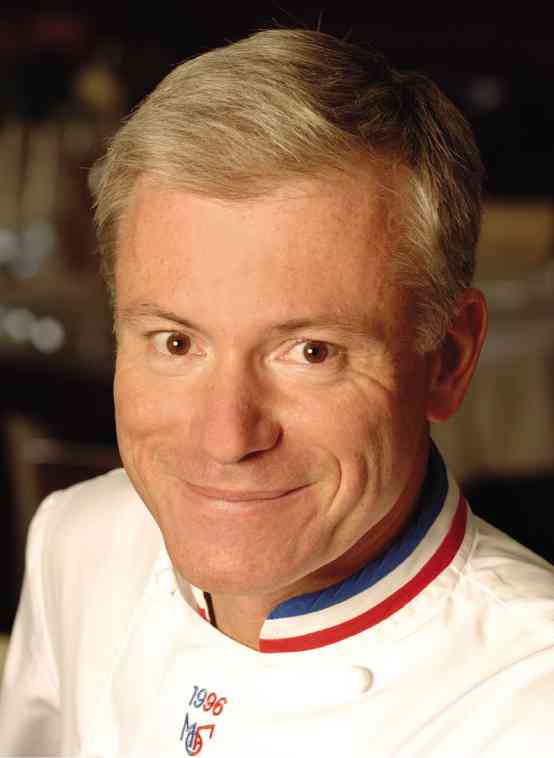
The schedules Skype interview was a meeting, again, of two French chefs—a mentor and former apprentice who are now friends, giving the encounter a convivial atmosphere with smiles and laughter in between questions.
The mentor, chef Christian Têtedoie, has a Michelin star for the restaurant that bears his name in Lyon, France. His apprentice and our interpreter, William Mahi, is chef de cuisine of The Tasting Room, City of Dreams (COD) Manila. Like his mentor, Mahi was once named Apprentice of the Year.
Mahi had worked in outstanding restaurants such as 2-Michelin-star Spondi in Athens, Greece.
The interview was just the start of a reunion that will culminate with Têtedoie and Mahi cooking from May 19 to 23 in a six-course degustation at The Tasting Room. Only 50 guests per dinner will be accommodated. The two chefs will cook different courses.
So, will Têtedoie do lobster and calf’s head—the dish he is famous for and which has been on his restaurant’s menu for almost three decades? The answer is yes; the dish, though an unlikely combination, was a challenge, Têtedoie said, but he knows that the diner will appreciate it because “it’s good.”
More pressure
According to a past article, the original version had the calf head sautéed, ending up in a crisp exterior, with the lobster added along with a carrot jus. But every year and every season, Têtedoie has a different version which delights him primarily; recreating, he said, is part of cooking.
It was creativity that certainly earned Têtedoie a Michelin star in 2000. Such recognition puts more pressure on the recipient to keep or add to the star, he pointed out.
Yet, while rooted in the traditional, Têtedoie dared to make changes in how French sauces are made. Instead of heavy creams and stock, he opted for the lighter vegetable jus.
We asked whether Lyon, where he is based and which is also home to many outstanding chefs, is considered the center of French gastronomy. He laughed and so did chef Mahi.
After a moment’s reflection, he decided to quote his own mentor, Paul Bocuse, who said Lyon has the best products, not necessarily the best chefs.
There is a big market in Lyon but no large-scale farming, Têtedoie said, adding that he will not talk about Paris. One senses a rivalry between the two gastronomic cities.
Since Madrid Fusion Manila just had a successful debut, we asked if a similar exchange of ideas between French and Filipino chefs could happen. Têtedoie is, after all, the president of the Master Chefs of France (Les Maitres Cuisiners de France), a worldwide association of French chefs, whose membership is by invitation only.
Têtedoie admitted that while he organized the association in the US and Asia, French cuisine has not been promoted in the Asian region in the last 10-15 years. He knows that he and other master chefs have the task of convincing people that French cuisine is not dead; the same goes for French fine dining.
Traditional ways
The dinner at The Tasting Room is only one event to showcase the new French cuisine, one that aims to attract global attention but still respects traditional ways of cooking.
When asked if he has ever been to the Philippines, Têtedoie said he had cooked with chef Cyrille Soenen of Brasserie Ciçou about three years ago. Soenen confirmed this and said that a friend of his, also a chef, knew Têtedoie and said he could bring the famous chef here.
The result were the two sell-out dinners at Ciçou featuring the cuisine of Lyon. But more important to Soenen was how his restaurant team learned a lot from Têtedoie.
“It was fantastic to have a chef of his caliber in Manila,” Soenen said.
Last March, Soenen was made a Master Chef of France, the only one in the Philippines and one of eight in Asia.
How does one graduate to be chef de cuisine like chef Mahi?
Têtedoie said a mentor has to be generous with his knowledge and should inspire the protégé. What he does is give an idea to his sous chef, then lets him do the execution of the idea. Of course, he said, one can learn from other sources like books, magazines and even friends.
Flexing culinary muscles
After a while, it was time to go. The timing of the interview overlapped with his restaurant’s lunch service, but Têtedoie seemed quite relaxed throughout the chat.
A view of the weather outside showed a bright sunny day in Manila.
Chef Mahi himself had to rush to The Tasting Room as it was time for dinner. We would have wanted a preview of the menu—cold appetizer of beef tail ravioli with purple asparagus and Greek yogurt, and one which points to his Basque roots, the Kintoa crispy pork trotter with pimientos and Iberico ham.
Alas, the ingredients weren’t available at the time.
We didn’t really settle for second best, because Mahi still flexed his culinary muscles and gave us a sample of why The Tasting Room is now the talk of the town.
Names of dishes were not those expected, except for the mushroom cappuccino. The duck liver terrine was in a spicy red-wine jelly; poached egg floated on potato mousse; salmon and clams sake tasted like the ingredients but didn’t look like how they should appear; the French lamb saddle was presented on a bed of aromatic rosemary and then placed on the plate with stuffed macaroni; and the mille-feuille was a work of modern art.
Wines were served, paired with each course and recommended no doubt by restaurant manager Damien Planchenault, who worked for many years as sommelier, including a stint at Christian Têtedoie in Lyon.
So, he, too, will have a reunion with his former chef.
The Tasting Room, tel. 8008060; e-mail guestservices@
cod-manila.com
E-mail the columnist at [email protected]














































